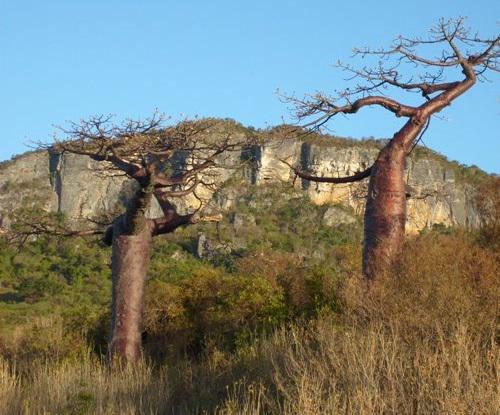Onja Hariveloniaina Razanamaro
Malagasy baobabs (genus Adansonia) are considered as one of the “flagship species” in Madagascar, attracting tourism. However, these plants are highly threatened and all species are classified as Endangered (IUCN, 2017). Adansonia suarezensis is endemic and the most threatened species. Connections between populations have been reduced and this has resulted in lower genetic variability and diversity resulting in a restricted range with an ageing population. We suspected that this situation is due to the fall in the population sizes of key pollinator species, such as the endemic fruit bat Eidelon dupraenum which has been identified as the main pollinator. The general aim of this project is to evaluate the effects of spatial isolation due to forest fragmentation on the gene flow of A. suarezensis in order to generate a management plan for the conservation of these iconic endangered tree species and the pollinator species on which they depend.

A. suarezensis population at Montaigne des Français.
Human activities can lead to destruction and fragmentation of natural habitats and cause major threats to biodiversity and ecosystem functioning. Land use practices, including logging, mining, and slash and burn agriculture (tavy), are the main threats to Madagascar’s biodiversity. Such practices have led to habitat loss and fragmentation that may potentially restrict or eliminate gene flow between populations and result in rapid population declines, reduce genetic diversity and offspring fitness, and increase extinction risk. Gene flow is a spatial movement of alleles, and a large proportion of gene flow in plants is achieved by pollen transfer. Therefore, analysis of the patterns and amount of pollen transfer is important for studying the many fundamental aspects needed to understand the regeneration process of a plant population, the amount of gene exchange between individuals and communities, and the degree of genetic isolation in a population.

Fresh opening flower of A. suarezensis.
Adansonia suarezensis, a Malagasy baobab species, is currently classified as endangered (EN) regarding criteria B1 and B2c (IUCN, 2012) and Vielledent et al., 2013, predict that without intervention and conservation efforts it may become extinct between 2050 and 2080 due to climate change. Leong Pock Tsy et al., 2013 also identified use microsatellite typing that the population of this species in the north (near Beantely) shows considerable genetic homogeneity. Among the three population sites identified, two sites exhibit a low genetic diversity. We have recently discovered a new Adansonia suarezensis population near Ambondromifehy and this site appears holds a healthy population of this species which we also intend to include in the study and compare genetic diversity with other populations.
We propose that the lack of genetic diversity in the two populations is caused by the absence of pollination during a flowering period (June to July a year) and the lack of gene flow. The endemic bat species Eidolon dupreanum, is a medium-sized megachiropteran (300 g) that feeds on nectar, and was the only mammal species recorded when visiting A. suarezensis populations. The occurrence of this bat species peaked at the reported times of maximum A. suarezensis nectar concentration (Andriafidison et al., 2006). Flower-visiting by bats provide some important benefits to plants because they deposit large amounts of pollen and a variety of pollen genotypes on plant stigmas (Collevatti et al., 2010). However, this Malagasy endemic bat species is threatened by hunting due to the high demand for bushmeat and also threatened by the destruction of their native habitat (Jenkins and Racey 2008). This species is classified as endangered (IUCN, 2005). Bat activities, including pollination, are also subject to various forms of disturbance and sensitive to habitat degradation (Quesada et al., 2003).
Considering the high threats to both the baobab species and its bat pollinator, we are faced with the extinction of both of these mutualistic partners, since the extinction of either species will cause the loss of both.